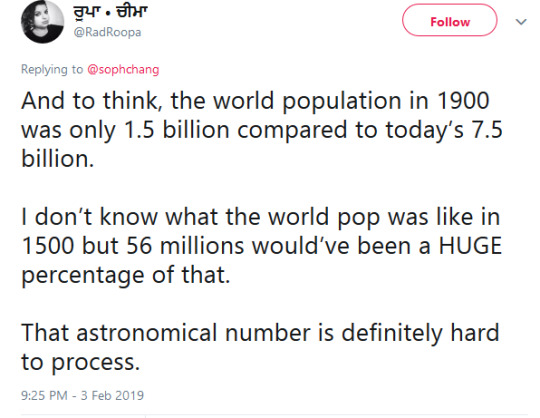Don't wanna be here? Send us removal request.
Note
Hello. I am writing a college paper on the early days of the gay rights movement prior to the AIDS crisis, and organized opposition to the the gay rights movment. Do you have evidence of the Jewish Defense League's anti-gay stances that I can cite, quote, research or refer to? I am looking for primary source materials particularly from the 1970s but if you have anything even after that, I would be grateful. This is the first time I've read about this group. Thank you!
Sorry I havent been on tumblr in quite a while. I am much more aware of racism, anti-Black and anti-Arab/Muslim, and anti-communism from the JDL. I don't know if there are any online archives of the Jewish Press, a Brooklyn NY publication that spread a lot of Meier Kahane's reactionary Zionist diatribes in the 1960s and 70s and that helped birth the JDL, but that might be a place to look for primary source material.
0 notes
Link
The Power of the People is the Force of Life by Michael Novick, Anti-Racist Action-LA/People Against Racist Terror (ARA-LA/PART) I was sent the following link to a piece worth reading by Henry Giroux: A searing and penetrating essay by Henry Giroux: https://truthout.org/articles/racist-violence-cant-be-separated-from-the-violence-of-neoliberal-capitalism/
1 note
·
View note
Video
youtube
VOTA NO Y SALVA PACIFICA
Vote NO! on the anti-democratic Bylaws revision at KPFK/Pacifica
1 note
·
View note
Text
Comrade Malik Speaks: Forever Free!
Not removing this, but people need to be aware that Malik, upon his release from prison, was revealed to have functioned as a jailhouse informant to the authorities, and was criticized and removed from any offices or responsibilities by groups he had associated with, including the NABPP (Prison Chapter) and the SF Bay View newspaper.--MN
Forever Free!
by Keith 'Malik' Washington (Chief Spokespersyn for the End Prison Slavery inTexas Movement)
Peace and blessings sisters and brothers! It's me! Comrade Malik, your soldier for change reporting in from behind enemy lines. I am currently at the Joe Corley Detention Facility in Conroe, Texas. The countdown to my final release has begun.
I still have a short stretch to do but this is nothing compared to the Twelve Long and Hard years I did inside the Texas State Gulag and Slave Kamp. My support team and I have a saying which is common among Abolitionists throughout the world, and that saying is: The Struggle Continues!
Today, I want to introduce to you an extremely and gifted Poetic Activist named Romello Lee from the incredible and awesome metropolis known as Houston, Texas. Actually, there are many talented and aspiring musicians, artists, and community activists on lock. However, Romello's mature personality and strong character got my attention.
Romello's story needs to be told and actually heard by the public at large. He has been falsely accused and charged with Humyn Trafficking. I know that this may sound controversial to many, but this INNOCENT, Young, and Islamic man deserves an opportunity to be heard. If you won't listen for my sake, then I ask that you listen for the sake of HAZEL who is Romello's beautiful and intelligent baby girl.
You see sisters and brothers, I have always been pragmatic and calculating when I ask y'all to help me MOVE on something. When I take a chance on advocating for any cause or any individual, I diligently do my homework and research. I need y'all to know that Romello went to Trial in the State of Texas on these charges and was Exonerated! Romello beat not one, but TWO Life Sentences and Six additional charges!! I want all of you to think about that for a moment.
Now ask yorself: "If Romello beat these charges in the State by trial why did the FEDS select him for this Modern day Lynching and Slavery! You see sisters and brothers, this Modern Day Lynching of young BLACK Males is not something isolated to the State of Texas. On the contrary, this is a pervsive and systemic problem which exists throughout the Criminal Justice system in Amerika!
We saw this clearly in the case of Meek Mill and it has contined for decades in the case of our shining prince and imprisoned Servant of the People Mumia Abu Jamal! And now we are witnessing this travesty of Justice with our brother Romello Lee aka 43VA (FOREVER).
Sisters and brothers and Comrades in struggle, this Freedom Campaign is not just about Romello, it is about those who will come after him also.
I am talking about the falsely accused wimmin and men who become victims of overzealous prosecutors or Ill-Intentioned F.B.I. Agents seeking promotion and advancement no matter the cost or consequences.
With that said, I want to introduce y'all to my brother in Islam and our Comrade struggle--- Hazel's DAD, Mr. Romello Lee!
(RO’MELLO):
hello from the otherside, (Ameen) this life of trials & tribulations, not a dollar sign to sin but sacrifice with an open heart, to be cheated on both sides by selflessness & misunderstandings! What rules the world when you cant put a price on a piece of mind? Damn, i never envisioned myself facilitated again, seeking a wrongful conviction ruling, behind bars, through a glass, in a dorm, looking down dejected and depressed!
Sometimes the right thing is the wrong thing, as what’s "wrong" could be righteous. Have you ever been passionate about sing someone you didn’t know, for no reason? Have you ever owed somebody your life, when they never gave you anything?
My brother kedrick johnson mentioned, some people only love you for what you can do for them/saviour. Imagine that when they're talking about the objects you love the most, in the whole-wide-world.
I understand it’s your heart by choice, your decision. Will you always be here, regardless, right or wrong? You would’nt want to be here either if you were innocent, would you? I don’t think so, when you’re subjected to viewing killings your first night federally imprisoned. Shanks, & people being thrown from a second floor balcony!
Same blood on these jackie chans (original lowtop vans) may have come from the snake bites, cuts or wounds left open, that they tell "U.S." (us) to breathe with!
But, i was hurting too remember? Then god shouted, "forgive" & he'll see it through, if not to lean on my own understanding, my spirit then quivered!
(Al-fatihah)
I'm doing months/calendars, on top of my time, uncharged! But, it’s righteous? For an hired agent, to take a stand & lie under oath, not even know the accused victims, or suspects govt. info., ages or etc. in a case investigated & on-going for over three yrs. & so, much more against, defendant, a man memorable, studied and covered in tattoos that could not be identified!
I know they hate, fire vs. Fire/Power. I'm fighting the oppressors!! I need y'all help! i miss my child!
My daughter needs me.. Not just a voice to put her sound asleep, but to shape, mold & nurture her to prepare her for this world, that is moving way too fast!! (You have to reverence the wound that bore you!!)
Now, you’re a long way from a rap battle with the state of texas!
this, is not, harris county? Your detained by the U.S. Marshalls? 25 yrs. To Life in the 3rd round? What do you say to the Mic? now do they love you? let my sisters & brothers speak for me! (Chant) END-PRISON-SLAVERY-IN-TEXAS!!.. forever, foreva, 43VA.
Ex-Alias (Moreno)
@rgcmoreno2x
www.chestrecords.bandcamp.com/win
Song : Eminem - Mockingbird.
0 notes
Text
Sirens
Sirens
I live in the city of L.A. near Culver City's environs
And any hour of every day, I am besieged by sirens.
Ambulances, paramedics, fire engines and cops --
each walk or bike ride I take, the wailing never stops.
When I try to cross the street, they go tearing through the light.
And when I try to go to sleep, they go screaming through the night.

For weeks in Europe with hardly a claxon, I enjoyed the quiet.
Back in the US, it was copters and choppers, like a war zone or a riot.
Squad cars racing down the block. flashing lights and siren blaring
give the lie to their claims of serving, protecting, or caring.
Their constant piercing presence is an assault upon our senses
to which fingers, plugs or ear-buds can offer no defenses.
The shrillness seems designed to trigger post-traumatic stress,
to transform quiet neighborhoods into an auditory mess.
Like Ferguson's brazen cops chanting "Whose streets? Our streets!"
the sirens transform peaceful blocks into occupation beats.
Homes and stores that police sirens ceaselessly surround
become virtual prison cells behind intrusive walls of sound.
The sirens sound a warning horn, a threat of further violence.
I'm working towards a better morn, a day with blessed silence,
Without teargas, gunshots, spying, when the sirens finally cease,
The day on which we finally can abolish the police.
https://www.youtube.com/watch?v=cgmkRahxuA4
0 notes
Text
Brilliant history of indigenous North America from Quora
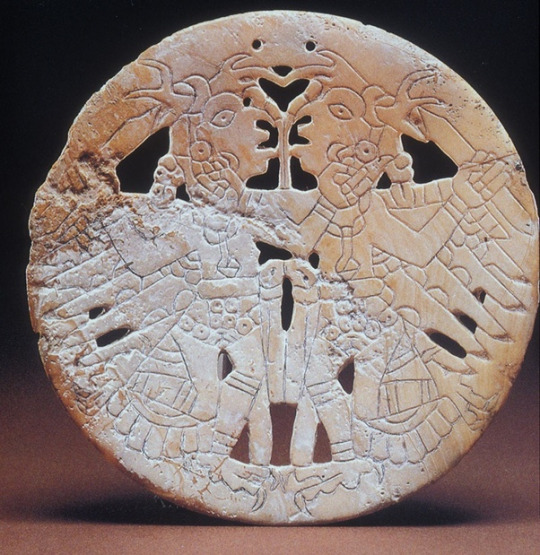
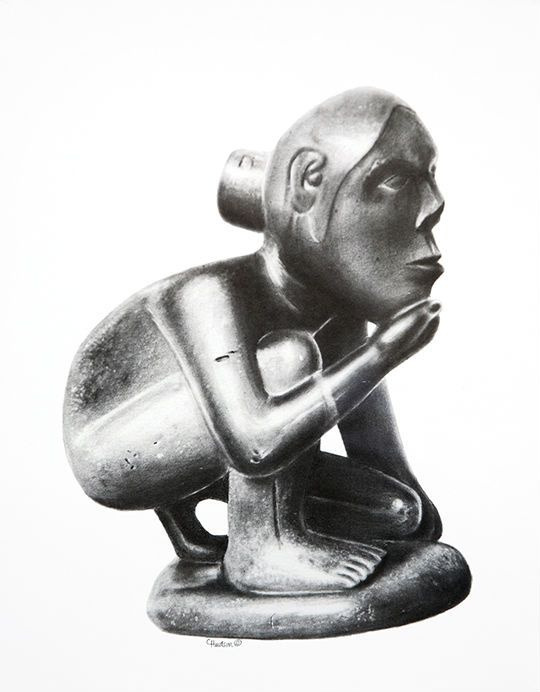
Why did no ancient civilization come up the Mississippi river valley even though it had similar conditions to other river valley civilizations?
Jonathan Hall
, Sapient primate since 1996, enjoys learning about things
Updated Jan 27
· Upvoted by
Roderick White
, PhD Ancient History, University College London (2018)
It really is a pity that even today, despite all the literature, museums and outreach, even the average citizen of the eastern United States is still blissfully unaware of the complex societies whose remnants they often walk or drive right over.
Story time!
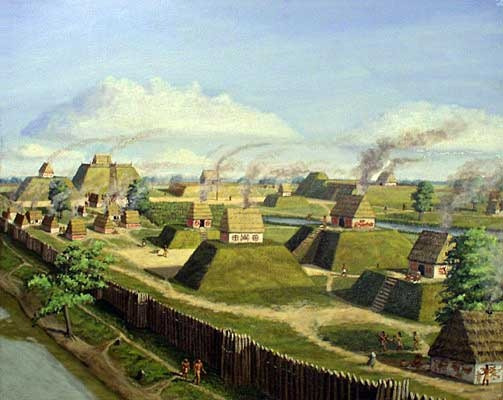
The Eastern Woodlands of the United States has been a nexus for stratified civilization since 3500 B.C. The Mississippi River area was even home to its own independent cradle of agriculture known as the Eastern Agricultural Complex, from which we still have popular vegetables like squash and sunflower. The peoples that farmed these crops have been traditionally termed the “Mound Builders”, so named for their apparent proclivity towards earthworks. The term is a bit dated now, and archaeologists today are able to differentiate specific cultures, but “mound-building peoples” is often still used to describe the cultures in general.
There have been many mound-building societies over the course of North American history. We’ll probably never know the exact political relationships, but we can identify consistencies in material culture and living patterns. The first one that really seems to take off across the board is the Hopewell:
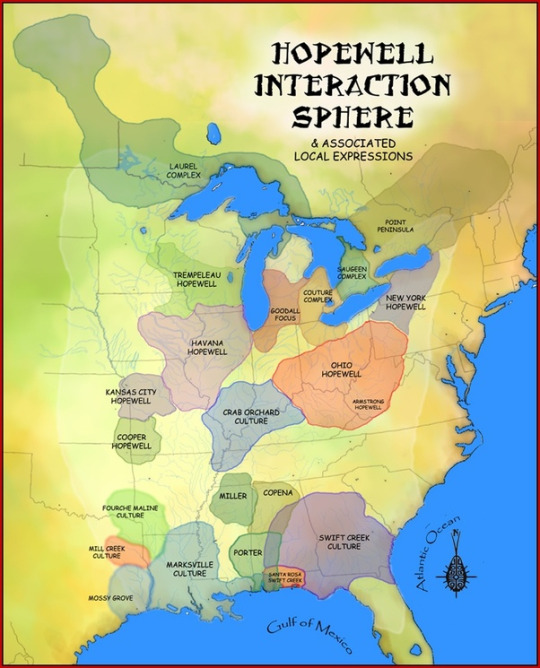
Starting around 100 BC, sites all around the Mississippi start adopting a similar set of traits such as pottery styles, arrowhead techniques and artistic motifs, along with a much more pronounced sense of social stratification. The Hopewell appear to have begun with the Ohio Hopewell, which built upon the stratified Adena culture that existed since 1000 BC on the Ohio River valley, which connects to the Mississippi. The Hopewell greatly proliferate the number of mounds constructed in the Eastern Woodlands and diversify their uses.
One of the most iconic examples of the Hopewell are the Newark Earthworks: a series of interconnected circles, walls and moats that appear to serve as a massive lunar observatory. The Moon’s orbit ‘wobbles’ in relation to the Earth: at one extreme the orbit is rotated one way, and rotated the other way at the other extreme. The point in this cycle where the Moon’s orbital plane reaches its northernmost or southernmost extent before going back to the other is termed the lunar standstill, which produces an effect not unlike the Sun’s solstices. This happens every 18 years, 7 months and almost 10 days. The Newark Earthworks are able to track the Moon’s declination until the next standstill with remarkable precision.

Newark today. A country club still owns parts of the earthworks.
It’s possible that the Ohio Hopewell had such influence over the Eastern Woodlands that they may have started a new religious movement, or perhaps their influence was economical and assimilating their culture was better for business, or people may have simply admired parts of their culture enough to replicate it. A mix of the three may have happened, but we might never know specifically why people wanted to copy them.
What we do know was that their influence was phenomenal. The Hopewell had access to a trade network that extended all the way to the Great Lakes, the Gulf of Mexico and the Rockies, with artifacts from these regions showing up in Ohio:
In the year 500, the bow and arrow trickled southward after being introduced by the Inuit from northern Canada. This makes hunting (and fighting) much more accessible, freeing people up from their dependencies on crops and some hierarchical control.
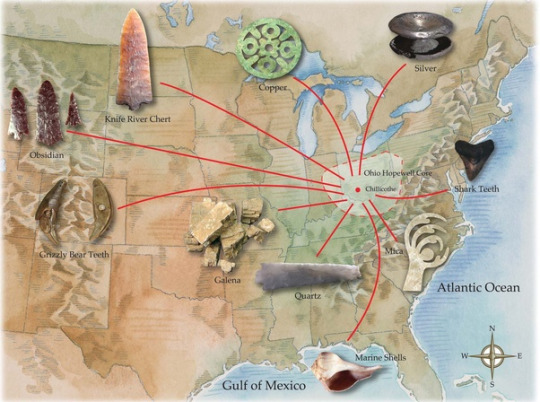
From there the magic begins to die for the Hopewell and the societies within its sphere fall into the geographically broader-ranging Woodland period. The 500 years of the Late Woodland period saw a great intensity in fortification, a significant reduction in mound-building (though some are still built) and more numerous, smaller walled villages instead of the larger towns of the Middle Woodland’s Hopewell. This lifestyle, in some form, actually lasted in the periphery of the Eastern Woodlands until the arrival of Europeans.
By the year 1000, however, something new appears in the heart of the Mississippi. People are once again gathering in large towns and forming wealthy elites under the control of powerful rulers who began using earthworks to proclaim their legitimacy. Corn (maize) was introduced to the Eastern Woodlands in 200 BC, but had a hard time dealing with the colder climates. However, new cold-hardy cultivars had finally been developed and were taking the Eastern Woodlands by storm into a new agricultural revolution. Things were about to get corny.
Archaeologists have given these corn-crazy, mound-building chiefdoms the aptly-named title of the Mississippians:
This is where things really start getting big. The power and influence of chiefs have increased drastically into large, multi-town paramount chiefdoms, though if we’re being completely honest some of these really resemble early kingdoms and the difference is largely semantic. The massive trade networks have fired back up and are bringing in more goods than ever before. They especially love Great Lakes copper. Art, culture and religious expression have also greatly expanded and this cultural movement reaches nearly every corner of the Mississippi River watershed:
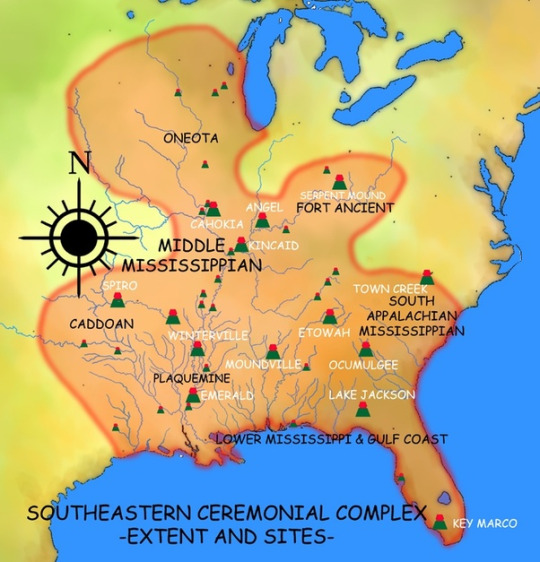
The “Sponemann Figurine” from Cahokia. The headwrap seen on her head has been documented in historical Native American tribes:
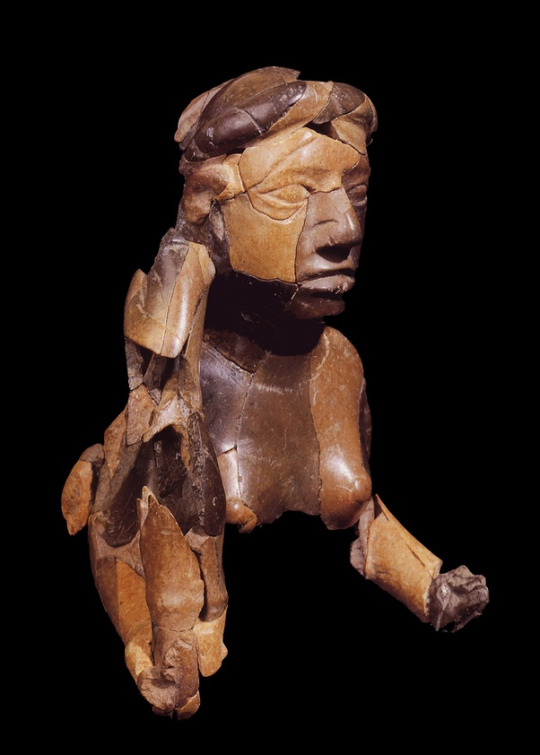
Copper plate of a falcon-eyed man from Spiro Mounds, Oklahoma:

“Crouching Man” effigy pipe from Shiloh Indian Mounds, Tennessee:
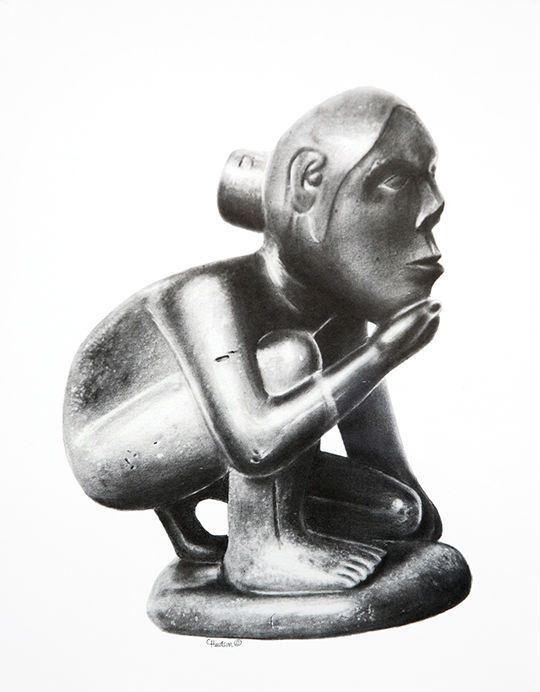
More Spiro copper plate art, including a falcon dancer (or warrior) to the left. These are replicas for Spiro’s museum exhibit:
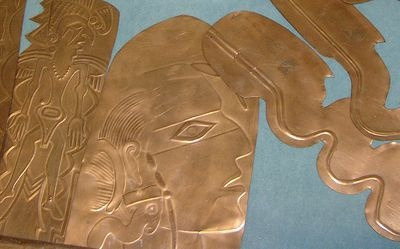
“Conquering Warrior” effigy pipe from Spiro. The wooden slat backshield he is wearing has similarities to the armor worn by Great Lakes tribes, which also protected the head and neck in this way:
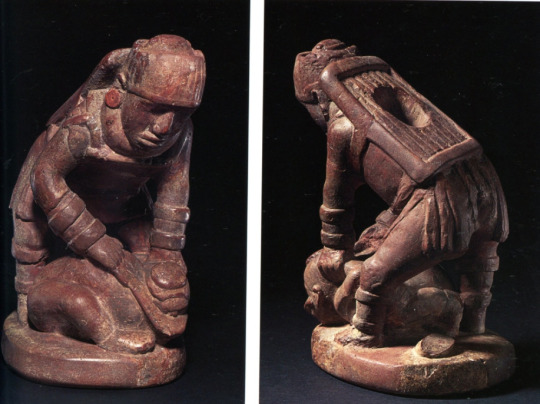
Wood duck effigy bowl, diorite. Moundville, Alabama:
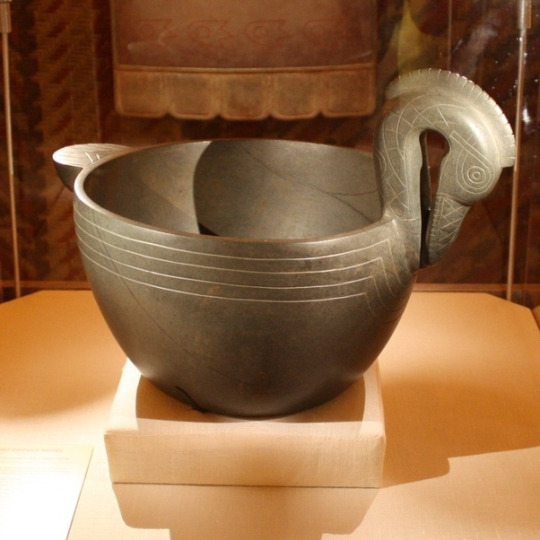
Shell gorget of two dancers from the McClung Museum of Natural History & Culture in Tennessee:
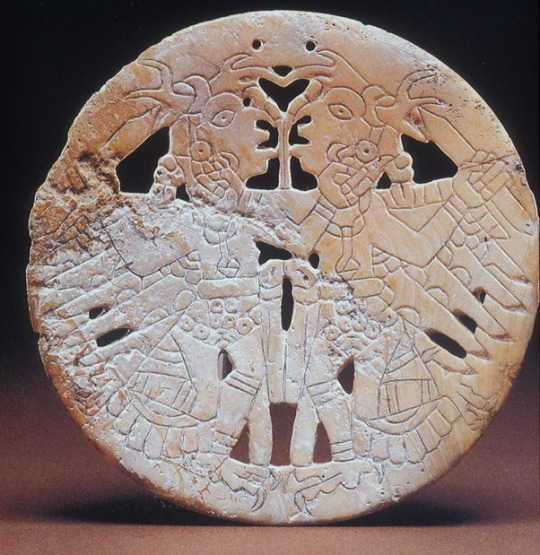
But one of the most profound examples of Mississippian culture, and what everybody wants to see when they visit the sites, are of course the mounds:
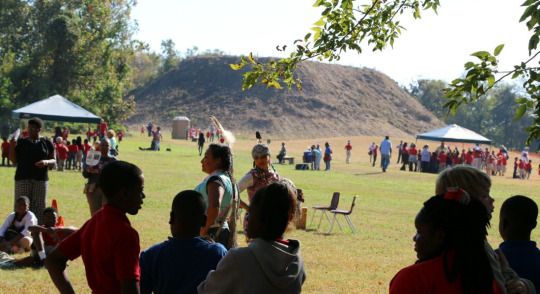
Winterville Mounds, Mississippi
These are no mere piles of dirt either, but alternating layers of various clays and particulates that each have their own physical properties and ostensibly spiritual meanings to ensure the greatest structural stability and proper religious status. Most of these clays were sourced from many miles out, even when a more convenient source was nearby. Most of these mounds were built to house a temple or chief, and the larger mounds served as residential-religious complexes for the elites. When the person living on the mound died, his house was burnt with any of his belongings and a new mound was constructed atop.
The most impressive of these Mississippian mounds, still standing today (in somewhat eroded form) is Monks Mound in the archaeological site of Cahokia:

This terraced platform mound is 100 feet high, 775 feet wide, and 955 feet long; slightly larger at the base than the largest Egyptian pyramid.
The mound held multiple large buildings, including that of the paramount chief who overlooked a city we call Cahokia, the largest in pre-Columbian North America north of the Rio Grande, existing from A.D 1050 to 1350.
And there’s a highway right through it…
(A little outdated: there is evidence of clay caps on many Mississippian mounds, which means these mounds would have been a bright yellow or red instead of turf green)
The safe estimate for Cahokia’s population is around 20,000 people, but it has sometimes been given twice that. Either way, it’s reasonably impressive for the area and historical context. Our modern life has made us used to megacities spanning hundreds of thousands or millions of people, but to put 20,000 souls into perspective: This is close to the same size as London in 1200. Berlin was a quaint village of barely over a thousand at this time. Paris had very recently become a medieval metropolis at a hundred thousand people, but had floated at around 35,000 for about a millennium. The modern city of Ithaca, New York is around 30,000.
This city was America’s first melting pot, bringing in peoples from very distant regions who came for trade, religion and safety. The city was organized into districts according to class and sometimes function, including ‘industrial zones’ for production of things like beads, tools, pottery and copper art.
Outside the walled ceremonial district was a “Woodhenge”; a circular arrangement of poles that track the position of the sun like a giant solar calendar. Nearly all of the buildings are aligned to the four cardinal directions; the four directions to this day are important to many Native American tribes. Some pits within the city were dug as a source of clay and, if we can glean from historical accounts of native towns, were likely flooded and stocked with fish.
Cahokia faced many typical issues of a large early city: social order, sanitation, dietary deficiencies, and especially resource exhaustion (good timber had to be brought in from upriver). In finding a reason for Cahokia’s fall, it seems to have dealt with these okay enough. But some time after 1200 AD came an unusually wet era for the Mississippians, and all that extra rainfall drained into and rushed down the Mississippi, which would have drenched all of Cahokia but the tops of its mounds.
Interestingly, the Osage tribe, a Dhegihan-Siouan people that have one of the closest cultural similarities with the archaeological findings of Cahokia, have an origin story that draws many parallels (from Willard H. Rollings’ The Osage: An Ethnohistorical Study of Hegemony on the Prairie-Plains):
. . . in the beginning all of the Osage lived in a single village located along a river. One day the river flooded, and the Osage fled the rising waters. One group made it to the top of a hill, while others fled a nearby timbered ridge. A third group escaped to higher ground and sought shelter in a dense thicket, while a fourth group found refuge at the base of [a] hill just above the floodwaters. Some of the Osage, unable to escape, remained in the flooded village. After the floodwaters receded, the Non-hon-zhin-ga [council] insisted that the people remain in the groups they had formed during the flood. They claimed that Wa-kon-da [the Great Spirit/Mystery] wanted the people to live apart and to establish five villages . . .
After the flooding, Cahokia was still inhabited, but was a shadow of its former self. The people that lived there in the roughly 200 years until its final abandonment seem to have lived without a major elite class and used parts of Monks Mound as a garbage midden. Cahokia, once at the forefront of the Mississippian trade network, seems to have taken the long distance trade with it.
…but that’s not the end!
Mississippian culture was still alive and vibrant in the Lower Mississippi and Southeastern Woodlands (and the Middle Mississippi and Ohio River too, but the other places are more intense). However, times have changed. The lack of the Cahokian trade nexus has wrecked regional economies. Influence vacuums have formed and the world seems just a bit more dangerous. This is where history begins to rhyme a bit: there is an increase in fortification and town splitting, though not quite to the same degree. Towns are typically surrounded by a defensive wall and people move if the population gets too big, but complex hierarchies and earthworks are more active than ever. The political climate of the Southeast leads to the creation of vast open territories, with areas of dense wilderness serving to buffer the territories from large military campaigns (though light travel is still possible on trails). These territories, of course, had to be managed. And it’s during this era that we are finally able to know how the Mississippians governed themselves, at least in some parts, due to the accounts from Hernando de Soto’s entrada. In the Southeast among Muskogean (Creek) towns, the major town leader (potentially the paramount as well) was the mico/micco. Subordinate to the mico are the orata, which governed satellite towns. The iniha/heniha was an administrator served along the mico as a kind of magistrate and the yatika was the official translator. Each of these large territories was an italwa, and this word was also used to describe the largest towns ruled by micos, talofa being the smaller towns. The Caddo Mississippians in Texas and Oklahoma had the same structure, despite being on the other side of the Mississippian sphere.
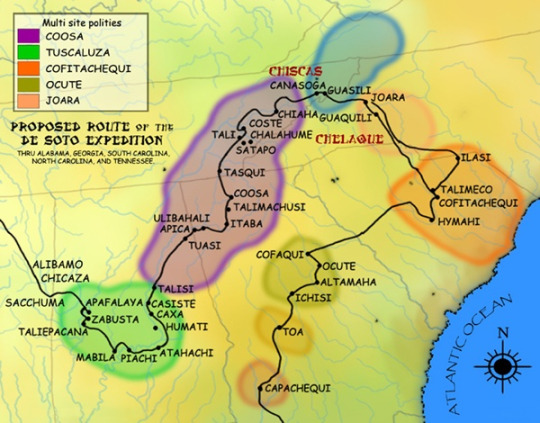
Hernando de Soto’s route through areas that are known Mississippian polities. There are more archaeological sites than shown here which could possibly represent other polities.
Starting from Florida, Hernando de Soto and his entrada entered Mississippian civilization, starting with the Appalachee (to the south, off-screen of the map) and into the Mississippi River proper. There they found large capitals with their mounds and walls, and many towns had other features such as moats and levies. Some of these moats seem to have doubled as fish traps, according to de Soto’s secretary Rodrigo Ranjel who described Pacaha’s (probably the Nodena site in Arkansas) moat as ”full of excellent fish of divers kinds”.
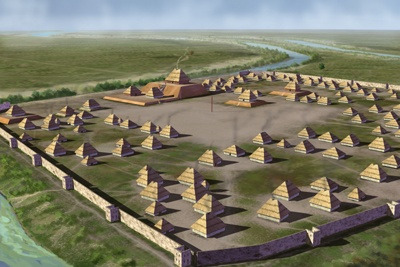
The Parkin site in eastern Arkansas, one of the places visited by Hernando de Soto
You will often hear that from here, Hernando de Soto’s very existence caused 90% of the natives to keel over from European diseases. However, there is actually no evidence of such mass deaths, even in towns that had Spanish artifacts. To make matters even more interesting, De Soto and some other Spaniards actually fell ill and died on this journey, at a point in the journey longer than the incubation period of known European diseases, with the natives unaffected!
But the entrada still had a devastating effect on the political atmosphere. In his search for gold and the desire to continue such a journey, de Soto raided and burned towns, forcibly occupied capitals and even kidnapped paramount chiefs — people who were supposedly of heavenly descent, reduced to being bound and caged for ransom. He used his influence to alter Mississippian political relationships to his benefit and this wrecked the status quo. The paramountcies of Coosa and Cofitachequi no longer had the same kind of respect, influence and control over their territories as they once had. Political cohesion was now much more tenuous.
The entrada would not be able to walk away from the Eastern Woodlands so easily, however. Shortly before he died, de Soto tried to use his claim as son of the Sun to force the chiefdom of Quigualtam, the largest and most powerful polity of the lower Mississippi, to give them safe passage down the Mississippi…and some tribute for the road, of course. Quigualtam wasn’t buying it. After a failed overland route near Texas, De Soto’s entrada (now led by Luis de Moscoso) built some ships and tried to sail down the Mississippi as quick as humanly possible.
Quigualtam, of course, caught up with them. The small Spanish river fleet was met by Quigualtam’s fleet of nearly a hundred canoes, many of which held up to 70 people. These large canoes had awnings in the back housing the commanders; the awnings, paddles, weapons, and the boats themselves were all one color, with a different color for each boat. They sang and drummed in unison to pace their paddling; most of the songs could be summed up as “You Spaniards sure are in for it now!”. There was, naturally, a very loud scream at the end of each song.
Once the boats got close, teams of divers jumped off the boats and into the water to board the Spanish’s pinnace boats. Other paddlers stood up and began firing volleys. They managed to kill, wound and capture some people, but made the decision not to engulf them entirely — Quigualtam’s plan was not to annihilate the Spaniards, but to harass, exhaust and terrify them enough that they understood who had the real power in the Mississippi, and would tell all of their countrymen back home. Which of course succeeded: every time the Spanish thought they out-sailed Quigualtam, they would hear the shouting again and the terror would start back up.
Quigualtam’s cultural descendants are the Natchez, whose society remained strongly Mississippian well into the historic period, interacting diplomatically with the United States.
Despite this successful expulsion of the Spaniards, it was only the beginning of the end for the Mississippian way of life as a whole. European ships were conducting slave raids all around the North American coast, as well as propping up some natives to become slave raiders themselves, which only expanded ever inward. This led to an increase in warfare, famine and mass uncertainty that undermined the political structure of the Eastern Woodlands, leading to the breakup of most Mississippian polities. It was only when the stresses from raids and starvation was at its peak that the first epidemics begin to sweep through; these events had lowered the immune system of natives. The Native American slave trade continued well into the age of the British colonies and early U.S., where Savannah, Georgia was an important port for the export of Native slaves.
De Soto’s accounts were buried in the libraries of New Spain, records of English colonial interactions with remaining Mississippian polities fell into obscurity, and the survivors of the Mississippian breakup had long since adopted new, somewhat more egalitarian lifestyles. Many of the old Mississippian towns and cities were revisited again as abandoned mounds. Rather than believe they were built by the ‘savage’ Indians they were killing and enslaving, people came up with numerous myths of other more prestigious people who came to America before them, only to be killed off by the current inhabitants. The Aztecs. Hindus. Babylonians. The Lost 13th Tribe of Israel. The Welsh. Anyone but the indigenous people. Thomas Jefferson was one of the first, after archaeological digs of his own, to suggest that the mounds were in fact built by Native Americans.
But the myth had always persisted. In fact, some pseudo-scientific circles to this day still deny the origins of the mounds in favor of their preferred civilization. And the lack of respect Americans have had for the mounds is exhibited by their constant destruction throughout American history. Massive temple platforms were excavated so their clay could be used for road fill or embankments. Some were simply in the way of progress: right across the river from Cahokia was the remains of a smaller city which was nearly completely torn down to make room for St. Louis. Only one deeply eroded Sugarloaf Mound remains. Many Mississippian sites are still on private land, their artifacts routinely dug up by plows while their discoverers don’t think much of it.
This has been simply another front of a campaign as old as the United States itself to destroy and mask the history and culture of Native Americans, so as to put European-American history and culture at the forefront. Today, we are more sensitive to the real history before the United States, and also have the power and resources to protect and educate. But the damage inflicted over the centuries has been done, and we are still reeling from its effects. It will take a while before Americans really truly become aware of their country’s pre-European past and realize it’s something to be celebrated, not quietly ignored. Until then, we should try to educate and raise awareness as much as we can.
As you can see, the Mississippi River did indeed give birth to some quite complex societies. You might also be wondering: why didn’t all this complexity happen earlier? Or reach the political strength of other river valley civilizations?
Well, first off I don’t think you can ever get a detailed answer to that. Many people like to fall on geography as the sole determiner of human society, but humans, as we all know, are complicated and do not like to follow the rules. Nevertheless, while the fertility of the Mississippi watershed can’t be overstated, the region is also perhaps a bit…too fertile. Most other river valley civilizations are in relatively dry areas, with a narrow stretch of fertile floodplain that forces most people to huddle together and submit to a central managing authority. In the Mississippi, you can have great farmland by the river, but you can also go deeper into the many, mazelike tributary rivers into the woods and have almost just as productive a crop. This is harder to keep under control, which narrows the focus of elites for the most part. However, ancient China had much the same layout: a large swath of fertile land under a complex watershed of not one but twogiant rivers. Horses, not available to the Mississippians, may have also played a part in such a difference. Or perhaps simply not enough time has passed since the Eastern Woodland’s adoption of agriculture in 1800 BC and the introduction of more efficient crops in 900 AD. If you’re asking me, a historical particularist, I believe that the fate of human societies can ultimately fall on the decisions made by their communities. The ideologies that led to the creation of sprawling, intensely bureaucratic states simply did not come to fruition in the same way they did in China or Mesopotamia. Maybe that was influenced by the factors I mentioned, or the values were simply different.
Yet a civilization it definitely was, with its own sophisticated cultures, politics, and artistic expression. Like many civilizations, it had its own peaks and dips, and with every dip rose a peak that was stronger than ever before. The collapse of the trade networks after 1400 was a dip the Mississippians had just begun to recover from. Considering the interruption of Mississippian history with the arrival of the Spanish, one has to wonder: what kind of peak might we have seen next?
Further Reading:
Mysteries of the Hopewell: Astronomers, Geometers, and Magicians of the Eastern Woodlands by William F. Romain
Ancient Cahokia and the Mississippians by Timothy R. Pauketat
Medieval Mississippians: The Cahokian World by Timothy R. Pauketat and Susan M. Alt
Mapping the Mississippian Shatter Zone: The Colonial Indian Slave Trade and Regional Instability in the American South by Robbie Ethridge and Sheri M. Shuck-Hall - goes into the political instability caused by European activity that led to the collapse of many Mississippian polities
Epidemics and Enslavement: Biological Catastrophe in the Native Southeast, 1492-1715 by Paul Kelton - also discusses the shatter zone, but builds upon it by touching on the biological aspect. Particularly, it addresses the myth of the spread of European disease in the EW: rather than the wildfire-like instantaneous transmission many imagine, the worst of the epidemics only came about when the immune systems of the natives were weakened through stresses.
The Forgotten Centuries: Indians and Europeans in the American South, 1521-1704 by Carmen Tesser and Charles Hudson - very aptly named; in-depth exposition of the often overlooked protohistoric period, inbetween the jurisdictions of archaeologists and historians.
Amazon.com: Knights of Spain, Warriors of the Sun: Hernando de Soto and the South's Ancient Chiefdoms by Charles Hudson and Robbie Ethridge - Contains actual primary sources of de Soto’s journey, augmented and illuminated by the interpretations of modern historical and archaeological data.
1 note
·
View note
Text
Statement from Ruchell Cinque Magee, sole survivor of the Marin Courthouse slave rebellion
Attn: Carole, Socialist Viewpoint, and Mary, SF Bay View
From: Ruchell Cinque Magee
Date: January 1, 2019
Wishing New year's progress to all the community people pushing for change!
In regards to application for the Governor's pardon, it is my wish that you kindly mail the original form enclosed to California's newly-elected Governor G. Newsom by certified mail (and please return a copy to me).

Recently, I petitioned the Justices of the US Supreme Court in DC, requesting that they act as the "13th juror" by acknowledging the 12 jurors' documented acquittal of me; thereby they would run those corrupted and lying judges such as William H. Orrick, D. Lowell Jensen and other criminals alike out of the picture. (They are playing with people's lives; it has become a game to them.)
If the new governor is who he claims to be, for prison reform, he could use cases such as mine to send a clear message to the corrupted Parole Board: its days of making its own laws, in frame-ups, will not be tolerated.
My case is evidence: I've been in prison over half a century because the Board does not release victims of racist frame-ups, hate crimes, unless they have been driven crazy or peoples opposed to racism publicly campaign against the scum's cover-up.

The jurors in my case ruled me 'not guilty,' and documents by jurors B. J. Suares and David F. Smith tell some of what the jurors found illegal in how my case was handled, and required that high authority correct such illegalities, that go all the way back to the 1963 frame-up leading to my original imprisonment, and continuing through the way the judge railroaded me in the 1970 Marin courthouse case despite the jury's ruling for my factual innocence of the charges.
Since the out-going Gov. Brown did not act, the new governor's task regarding my acquittal in the latter case is simple: "Review the record!"
The jurors in my case, little though many community members may know, gave videotaped testimony regarding their vote to acquit me. Yet for years, the corrupted judges have failed or refused to address the acquittal issue all of these since a judge deemed me convicted and sentenced me; instead the appellate judges keep mouthing off about Magee, Magee, Magee again, filing too many legal documents.
Either the US Supreme Court of the new Governor of California are in a position to recognize the judges' abuse of power, and to put an end of the injustice of my continued incarceration. I will never accept slavery! No matter how many criminals in high places seek to justify it.

Ruchell Magee on trial, 1971
I remain,
Ruchell Cinque, Moving Forward!
0 notes
Text
Pacifica Issues Taken to Attorney General Xavier Becerra
Pacifica Issues Taken to Attorney General Xavier Becerra
Concerned about possible financial malfeasance, a flawed election process, and the gentrification of the airwaves, members of Pacifica Foundation’s KPFK radio station and national allies on January 8 filed a complaint with California Attorney General Xavier Becerra, whose office has oversight of California non-profit corporations. A simultaneous press conference was held, covered principally by Spanish-language media.

Pacifica fills a unique role as a radio network featuring progressive views, free of corporate influence. The Grassroots Community Radio Coalition, a lead complainant, has launched a campaign with its allies to restore transparency and accountability and is seeking assistance from the Attorney General to remedy violations of the Foundation bylaws and irresponsible governance practices that endanger the survival of this 71-year-old progressive foundation and radio network:
Acting contrary to the advice of its CFO, its General Counsel, and its Auditor, the Pacifica National Board (PNB) majority took out a $3.2 million loan and refuses to reveal to Foundation Members the loan details or to produce a repayment plan. This followed on the heels of a bridge loan, possibly involving self-dealing, that paid off a smaller debt to the Empire State Building real estate trust that threatened to sink the Foundation after a court ruling allowing that creditor to seize any and all Pacifica accounts to obtain payment.
Acting contrary to Pacifica bylaws, the PNB majority passed a motion that would illegally extend their own terms as Directors.
Acting contrary to the professional National Election Supervisor’s decision to terminate the election because it would be impossible to fairly conduct the long-delayed board elections due to inadequate membership records, and lacking a plan to remedy the cited deficiencies, the PNB majority nevertheless directed Pacifica’s Executive Director to proceed with elections. This forced out the NES, whose replacement has now also been terminated and replaced.
Acting contrary to its own acknowledgement of a conflict of interest, and despite a bylaws-compliant election timeline recommended by the second NES, the PNB majority violated the bylaws again by repeatedly setting its own timelines, which changed the qualification status of candidates as well as voters. The timeline was recently changed yet again by the third NES, including another retroactive date change for qualifying as a member or voter. The new NES also disqualified Sharon Brown, a Black female LSB candidate here in L.A. because she had previously been removed (improperly, according to a court ruling) from the KPFK LSB and the Pacifica National Board.
Pacifica governance is directing program changes to gentrify the airwaves, counter to the Pacifica Mission, endangering the Spanish-language and other community-based programming. Jerry Quickley, the Black “unimbedded” journalist and poet who has been one of KPFK’s most popular hosts and effective fundraisers, was terminated and removed from the air. Spanish language programming is pushed off the air during incessant fund-drives, and is threatened by the new Executive Director’s plan to “strip” program most of the day and restrict most community-based shows across the network to the same few hours currently occupied by Spanish-language programming at KPFK, thus potentially setting up a battle over crumbs among Black, Spanish language, indigenous, Asian, women’s, and LGBTQ programmers.

Jerry Quickley, removed from KPFK a second time!
Since KPFK went to a “strip-programming” model about a decade ago, with gate-keepers controlling access to the airwaves and limiting free speech and community engagement, its audience has been cut in half. The station has muted opposition to so-called “humanitarian” wars by the US and in some cases aired speakers advocating for US intervention in other countries in the “Middle East” and Central and Latin America, without countervailing views. It has lost touch with a whole new generation of creative resistance locally.
The violations of the democratic rules of elections and governance are designed to keep listeners and staff from exercising their voice and vote. Carried out mostly in secrecy, the decisions of the self-serving Board majority threaten the survival of the Foundation and prevent the stations from fulfilling their mission to serve the community and the cause of free speech, peace and justice.
GCRC has proposed a number of remedies to the Attorney General, including appointing an independent elections professional to take over running the Pacifica elections, mandating the production of an accurate and current list of all listener and staff members of the Foundation, enjoining the PNB directors from extending their own terms, and requiring that the PNB activate the Bylaws-required Committees of Inclusion at each of the stations, which are empowered to assure that under-represented communities are equitably involved in programming, staffing, management and governance of the five Pacifica stations, KPFA in Berkeley, KPFK here in Southern California, KPFT in Houston TX, WBAI in NYC and WPFW in Washington DC. Allies from all the other stations, where similar problems persist, have been involved in drafting these proposals, leading to the formation of a National Coalition for Accountability at Pacifica.

The Grassroots Community Radio Coalition brought these concerns and proposed remedies to the attention of the Attorney General. Grassroots candidates are running under protest in the improperly scheduled elections in order to bring these issues of financial mismanagement, illegality, and a lack of accountability or responsiveness into the light of day, and to activate the listeners. Supporters of Spanish Language programming and of Jerry Quickley’s show have scheduled a get-together at KPFK, 3729 Cahuenga Blvd West in Studio City for Saturday, January 12 at 11:30, prior to a scheduled meeting of KPFK’s new program director with the programmers, where more changes are expected to be announced. More information is available at www.gcrc-socal.org.
Founded in 1947, the Pacific Foundation is a public benefit nonprofit that operates radio stations in Los Angeles, Berkeley, New York, Washington D.C. and Houston, and shares content with more than 200 affiliate community radio stations around the US and in Puerto Rico. Pacifica is located in the digital, entertainment, energy, political and financial capitals of the US, all areas with huge and growing populations of young people of color, facing human rights crises of gentrification and displacement, police violence, homelessness and other issues. Community involvement to enable KPFK and its sister stations to live up to their potential to shape political dialogue and tap the creative energies of actual and potential listeners is essential.

Michael Novick
Michael Novick is a former KPFK Local Station Board chair and treasurer, a former Pacifica National Board director and treasurer, and current candidate for the LSB. He is a long-time anti-racist and trade union activist, a movement journalist and published author, editor of Turning The Tide and on the staff of Change Links. He has been a listener-sponsor member of Pacifica stations in NY, the Bay Area and southern California for decades. He is active in Anti-Racist Action, Interfaith Communities United for Justice & Peace, and IfNotNow, as well as around police and prison abolition. He can be reached at [email protected]
1 note
·
View note
Text
MURDER IS THE CASE
REPORTING FOR THE W.L. NOLEN MENTORSHIP PROGRAM
By CHAIRMAN KIJANA TASHIRI ASKARI
MURDER IS THE CASE:
THE CALIFORNIA MEDICAL FACILITY ADMINISTRATIVE STAFF HAS BLOOD ON THEIR HANDS!
By definition of the law, prisoners have a clearly established constitutional right to medical care, and this is per Estelle v. Gamble, 429 U.S. 97 (1976).
But apparently, this law is not applicable to New Afrikan Black People, based upon an 1857 United $tates Supreme Court decision, where the justices ruled:
“The Negro lies so far below Whites on the scale of created beings that they have no rights that Whites are bound to respect.”
--1857 U. $. Supreme Court Decision in Dred Scott Case
Article II of the United Nations “Geneva Conventions on Genocide” defines the crimes of genocide as meaning any of the following acts:
“committed with intent to destroy, in whole or in part, a national, ethnical, racial or religious group, as such:
Killing members of the group;
Causing serious bodily or mental harm to members of the group;
Deliberately inflicting on the group conditions of life calculated to bring about its physical destruction in whole or in part;
Imposing measures intended to prevent births within the group;
Forcibly transferring children of the group to another group."
There is no other way to describe what‘s going on at the California Medical Facility (C.M.F.) (aka “Vacaville”), in Vacaville, California, than what the concrete facts inform us of. And the facts are: “The prisoner class is being subjugated under a sophisticated form of genocide! (i.e., “Our standard of care is being met").
Hospitals, by design, are infrastructures that have been constructed to treat, care for, protect life, prevent significant illness/disability, or alleviate severe pain. [1.]
However, since my arrival to the California Medical Facility (C.M.F.) on September 5, 2017, I have witnessed everything but the protection of life, as it relates to the prisoner class. In addition to those prisoners sent to “X Corridor,” (i.e., “Hospice”) from every slave kamp in C.D.C.R., to suffer in extreme pain & misery via over-medicating medical prescriptions, while they await their inevitable demise...prisoners are also being maliciously & intentionally deprived of adequate health care via the crucible of “misdiagnosing” prisoners and outright refusing prisoners medical treatment.
I will simply point to two cases, to substantiate my point:
1.) On November 5, 2017, a New Afrikan brutha named Theaudra C. Williams (CDCR #C-47938, (V-Wing, Cel1 #101) also known as “Big Gangsta” from the Los Angeles area, went into a Diabetic Coma for 48 hours and died! Somehow, this New Afrikan brutha survived this ordeal, by being brought back to life by San Joaquin General Hospital Medical Staff. Brutha “Gangsta” attributes his survival to correctional officer S. Wang who found him lying slumped over in his cell, during the 1st Watch (1W) Count, wherein he called out to brutha Theaudra C. Williams numerous times, to which brutha Theaudra was non-responsive. Officer S. Wang then activated his Emergency Alarm, wherein an Emergency Team responded to perform CPR, but to no avail, efforts by CMF's Medical Staff to resuscitate were unsuccessful.
At no point, prior to this contradiction, did Theaudra C. William’s Medical Physician Dr. Petras, perform any tests on this brutha, or recommend that he be examined by a specialist, with regards to numerous complaints of chest pain, frequent urination, light headedness and so forth.
2.) On 10/22/2018, a second New Afrikan brutha named “Rasheed” (s/n Raymond Jackson) CDCR # C-21148, (V-Wing, Cell #243) from the Los Angeles area, was murdered by (C.M.F.) Administrative staff and their malicious and deliberate indifference to his serious medical needs.
Brutha “Rasheed” had been a kidney transplant survivor for over 25 years, thanks to the compassion of his brutha. “Rasheed” had been incarcerated since 1981, and never had a history of heart problems. But on 10/19/2018, brutha “Rasheed“ had begun complaining of chest pains & shortness of breath, and went “Man-Down” twice on 10/20/2018, and again, on 10/21/2018. Each time he went “Man-Down, ” and requested medical treatment, our designated Housing Unit Medical Nurse [2], blatantly ridiculed “Rasheed” openly laughing at him for all to see.
Sunday morning 10/21/2018, “Rasheed” was given an “EKG,” and was told:
“Since there was no pain in his le[t arm and/or the left side of his neck, there was nothing wrong with his heart.”
On 10/22/2018, at 2 A.M. in the morning, brutha “Rasheed” was found dead in his cell slumped over his typewriter, working on a legal petition for the courts.
Bruthas “Gangsta” and “Rasheed" are well known “jailhouse Lawyers,” who were a constant ‘thorn’ in the backside of C.D.C.R.! And there is no doubt, that this dynamic was a major factor that contributed towards C.M.F.'s Administrative murdering these bruthas!!! As brutha “Rasheed” was in the process of negotiating a $l-Million-Dollar settlement with C.D.C.R., at the time of his death!
If anybody knows these New Afrikan brutha’s families, please inform them of the truth, in particular, how C.M.F. Administrative has murdered their loved ones!
In addition, the W.L. Nolen Mentorship Program (W.L.N.M.P.) is asking the people, to voice their outrage to C.D.C.R. headquarters [3.] in Sacramento, California, and demand justice for these bruthas! How many more prisoners must die, before C.M.F. Administration is held accountable?!?!
ALL POWER TO THE PEOPLE WHO DO NOT FEAR FREEDOM!!
*For more information, Contact me at:
ATTN: W.L. Nolen Mentorship Program,
C/O Chairman KTA,
P.O. Box 7907,
Austin, Texas 78713
http://wwwkijanatashiriaskari.wordpress.com
E-mail: [email protected]
* REFERENCE NOTES:
[l.] The California Code of Regulations, Title 15, Section 3350, (1.); provides the definition for the standard of care entitled to prisoners.
[2 ] We have put out an all-points bulletin (APB) to locate and discover the name of this nurse. As she was immediately relocated and/or reassigned from V-Wing, Unit 4, after she murdered “Rasheed.” She has a heavy African accent, dark complexion, & is about 5'9” in height.
[3.] All letters are to be mailed to:
Attn: C.D.C.R. Secretary,
C/o Scott Kernan,
Sacramento, CA. 95814
1 note
·
View note
Photo

#ReleaseRuchellMagee longest held political prisoner in the US since 1963. @JerryBrownGov http://www.itsabouttimebpp.com/.../Release_Ruchell_Cinque... … (Address for Magee in link is outdated:) Ruchell Cinque Magee #A92051, CMCSP B3-138, PO Box 8103, San Luis Obispo CA 93409-8103 Please RT
0 notes
Text
Garcetti Carols
Jingle Bells, Garcetti tells
a hundred lies a day.
It's no fun to be unhoused
when Garcetti's cops hold sway
(repeat)
Cops with tasers sting, Shooting people down,
No fun it is to have to live unhoused in L.A. town.
(repeat Jingle Bells verse)

Said the night wind to the little boy,
Do you see what I see (repeat)
Coming down the street, little boy?
A cop, a cop, pulling out his gun,
If you're Black or Brown, you better run (2x)
Said Community Watch to the unhoused mom,
Do you hear what I hear (repeat)
Lying through their teeth, unhoused mom?
Garcetti's flacks, spreading his PR,
polishing his presidential star. (2x)
Said the Mayor to the people everywhere,
Listen to what I say (2x)
Heed my words, people everywhere!
Do you believe the evidence of your eyes,
Or will you accept my housing lies? (2x)
Said the people of LA to the mayor,
Do you know what I know (repeat)
Based on reality, Mr. Mayor?
Your cops can't stop the righteous folk,
Your housing lies are a bitter joke (2x).
(To the tune of Come all Ye Faithful)
Oh, come all you unhoused,
hard-up, desperate, starving
Oh come ye, oh run ye,
To City Hall!
The city has billions,
But it never builds you housing,
The Mayor will feed you lies,
Garcetti feeds you lies,
Unless, unless
You organize!
(To the tune of Frosty the Snowman)
Eric the Mayor is a greedy grasping guy,
With a smarmy smile and a hollow heart,
And a rep built on a lie.
Eric the Mayor is a fairy tale, they say,
He is made of ice,
but pretends he's nice,
So he can be Pres one day.
He likes to think there's magic in that
Sappy smile he found.
For when he slaps it on his face,
He begins to dance around.
O, Eric the Mayor
Is as jive as he can be,
And the landlords say he can laugh
And play the game down to a T.
Thumpety thump thump,
Thumpety thump thump,
Look at Eric go.
Thumpety thump thump,
Dumpety dump dump,
It's time to tell him NO!
Eric the Mayor knew
His greed was on display,
So he said, "I'll run and
have some fun
now before I fly away."
Down into Skid Row,
With a nightstick in his hand,
Running here and there all
Around the square saying,
I'll bust you if I can.
He chased folks 'round the streets of town
Right to a nasty cop.
And he didn't pause a moment when
He heard them holler "Stop!"
For Eric the Mayor
Had to hurry on his way,
But he waved goodbye saying,
"Don't you cry,
I'm back from DC some day."
Thumpety thump thump,
Thumpety thump thump,
Look at Eric go.
Thumpety thump thump,
Dumpety dump dump,
It's time to tell him NO!
2 notes
·
View notes
Photo















Getting A College Education, Behind Bars
llustrated by LA Johnson
Written by Elissa Nadworny
3K notes
·
View notes
Text
Yesterday, Today and Tomorrow: A Reflection on Making History
Yesterday, Today and Tomorrow: A Reflection on Making History
by Michael Novick for Interfaith Communities United for Justice & Peace (ICUJP)
The Rev. Martin Luther King Jr. said: “We are now faced with the fact that tomorrow is today. We are confronted with the fierce urgency of now.

”In this unfolding conundrum of life and history, there 'is' such a thing as being too late. This is no time for apathy or complacency. This is a time for vigorous and positive action.”

William Faulkner said: “The past is never dead. It's not even past.”

John Connor in the Terminator movies said: “The future is not set. There is no fate, but what we make for ourselves.”

The Buddha said: “The past is already gone, the future is not yet here. There's only one moment for you to live, and that is the present moment.”

Fidel Castro, facing imprisonment for attempting to overthrow the Battista dictatorship in Cuba, said: "History will absolve me," meaning that in the future yet to be written, justice and liberation would triumph.

In the Torah, the deity is said to have told Moses: “I call heaven and earth to witness this day, that I have set before you life and death, blessing and curse: therefore choose life, that both you and your offspring may live.” But the Abrahamic god is a contradictory one on this question of free will and how the future is, or is not, shaped by the past. On the one hand, "He will by no means leave the guilty unpunished, visiting the iniquity of fathers on the children and on the grandchildren to the third and fourth generations." On the other hand, "The son will not bear the punishment for the father's iniquity, nor will the father bear the punishment for the son's iniquity; the righteousness of the righteous will be upon himself, and the wickedness of the wicked will be upon himself."
I want to reflect on these ideas, that the past is present in the present, that the future is here now, and that, paradoxically, the future is ours to make.

Many people now pay lip service to the idea that the US is built on stolen land, that its wealth is derived from the stolen labor of chattel slaves, kidnapped from Africa and held as property. But these admissions are treated as a regrettable artifact of the past, for which perhaps some apology or reparation is due, as opposed to their being an immanent and on-going reality of the present, a continuing transgression. As Malcolm X, El Hajj Malik El-Shabazz said, "If you stick a knife into my back nine inches and pull it out six inches, that’s not progress. If you pull it all the way out, that’s not progress. The progress comes from healing the wound that the blow made. They haven’t even begun to pull the knife out. They won’t even admit that the knife is there."

If I steal your car, no matter how long I drive it around without returning it, I am driving a stolen car and guilty of possessing stolen property. If I steal your house and live in for a lifetime, and bequeath it to my children, they are living in a stolen house. These lands on which we live, unless we are indigenous to them, were stolen -- no, are stolen, and the lands, and the resources within them, are still being stolen as we speak. The coal that is being burned to light Los Angeles, and the air that is being fouled by its smoke, are being stolen from the Diné people. The White House was -- no, is, the product of slave labor. And people of African descent are still disproportionately and intentionally enslaved in a system of mass incarceration enabled by the Constitution and its 13th Amendment.

When the 3/5 rule was written into the Constitution, it was a compromise between two variants of white supremacists, those from states with few slaves, who wanted not to count the slaves or indigenous people at all for purposes of determining the size of Congressional delegations of the various states, and those from states with many slaves, who wanted to count all the slaves to determine how many representatives the slave-owners would get. Neither side in the debate had any intention of granting the slaves freedom, let alone representation, and they settled on the compromise of increasing the size of the Congressional delegation (and Electoral College votes) of the slave-owning states by a factor determined by 60% of the slaves they owned. That system held sway until the Civil War, after which, with the defeat of Reconstruction, the Southern states (and previously slave-holding so-called "Border" states), got what they originally wished for, Congressional delegations and Electoral College votes based on the entirety of the still-disenfranchised African-descent population. That is the situation that still holds true, except that the so-called "Solid South" switched from solidly Democratic to solidly Republican, resulting in two of the last 3 US Presidents being selected by the Electoral College despite losing the popular vote.

The border between the US and Mexico is as much an artifact of war and racism as the so-called "border" between the continuing slave-owning states and the no-longer slave owning states. It was -- no is, as Trump's latest actions clearly demonstrate, militarily imposed and maintained. Go to San Diego and Tijuana, or to El Paso and Chihuahua, and you will see that geographically, there is no border. The Rockies that begin in Canada extend through the so-called United States and right down through Mexico. The Gulf of California, that finger of the Pacific that separates the Baja California peninsula from the mainland of Mexico will some day extend, because of the movement of tectonic plates, right up the center of the central valley of Alta California (as the US state of California used to be known when it was still part of Mexico).

On so-called Thanksgiving Day, I attended a Lakota-led prayer circle in Long Beach (on a part of the Cal State campus that was and still is sacred to the Tongva people) for missing and murdered indigenous women, led by a Native woman whose sister was murdered. Throughout Turtle Island, so-called North America, including Canada, the US and Mexico, indigenous women are being murdered and disappeared at genocidal rates. This has become something of a national issue in Canada, and is internationally recognized as "femecidio" in Mexico. But in the US, it is hardly a blip on social media, and ignored in the corporate political arena, although it is very widespread in both rural and urban area in the US, including Los Angeles, which has the highest concentration of urban Indians in the country, and especially in the so-called "national sacrifice" areas dedicated to resource extraction and petroleum or shale slurry pipelines, such as in the Dakotas.
If the past and present reality of land theft, of slavery and of genocide, on-going in the current political, social, economic and physical-ecological environment, are not to shape the future as well, we must act now. We must self-critically examine our complacency, complicity and compliance. We must take action against the genocide of forced sterilization, mass incarceration and political imprisonment, obscenely disproportionate infant and maternal mortality rates for African descent and indigenous people, lower life expectancy on reservations and in ghettoes, environmental injustice, and the epidemic of racist police killings with impunity. People of conscience and good will must exercise our free will to push these questions to the forefront of today's political discussion and action, with urgency and immediacy.

After World War II and Hitler's genocide of Jews and Roma, the slogan "Never Again!" was put forward. We need to recognize that "Never" is "Now." We must face reality, acknowledge the sins and crimes of the history of colonialism and settler colonialism that have shaped us and this society and political system, and accept the responsibility to make history. If we do not, history will not absolve us.
0 notes
Text
Some books for the gift-giving season
Thumbnail Reviews by Michael Novick, Anti-Racist Action L.A.

The Man Who Fell From the Sky by Bill Fletcher Jr., 2018, Hardball Press, Brooklyn NY, 339 pp., ISBN 978-0-99913-584-6, $20. This period murder mystery by a leader of the left and labor movements features the lives of Cape Verdean migrants to the US in the US, particularly the Cape Cod area, and their contradictory relationship with both African-Americans and with white people in the US. It ranges over events that took place during World War II and their investigation and uncovering during the Vietnam War era. Although it begins slowly as Fletcher "sets the table" of his mystery within a family drama and the career goals of the amateur investigator, David Gomes, local reporter with ambitions to break a big story that will enable him to jump to a major metropolitan newspaper, Fletcher is able to expertly handle the historical (WWII) and "contemporary" (Vietnam-era) story lines and use them to elaborate the conflicted consciousness of Cape Verdean African immigrants seeking assimilation in the US as "Portuguese", and coming up against both US white racism and suspicion from African-Americans rooted in struggles to overcome slavery and Jim Crow apartheid.

This Won't Hurt a Bit: A Lenny Moss Mystery by Timothy Sheard, 2001, Hardball Press, Brooklyn NY, 350 pp., $15, ISBN 978-0-9814518-1-0. This is the entertaining first in a series of mystery novels featuring union shop steward Lenny Moss, custodian in a major hospital whom fellow workers see as a problem solver and rank-and-file advocate for their rights. Moss's efforts to represent a co-worker in a grievance that could cost the laundry worker his job draw him into an effort to win the man's freedom from jail on murder charges by exposing the real killer. Sheard, who is also the publisher of the Hardball Press, expertly mixes class consciousness, details of the hierarchies and bureaucracy of a hospital, and a puzzling number of red herrings and potential suspects. Reading it will entice you to check out the rest of the books in the series, such as "Some Cuts Never Heal," and "A Race Against Death." They all feature Moss as a savvy working-class labor militant and amateur sleuth, dealing with the vagaries of the criminal justice and privatized health care systems with practical knowledge, solidarity and street smarts.

To Protect & Serve? Five Decades of Posters Protesting Police Violence/Proteger y Servir? Cinco decadas de carteles protestando la violencia policial by the Center for the Study of Political Graphics, 2018, CSPG, Culver City CA, $20. This bilingual, profusely illustrated volume is the catalog of an exhibited mounted by the Center earlier this year from its extensive archive of movement posters. It covers struggles from the 1960s to date, all of them touching in one way or another on police violence, racist abuse of power and repression. But given that anchor, themes range widely, including resistance to the Ku Klux Klan, opposition to imperialist war, struggles to free political prisoners or defend labor, gay or women's rights. It includes both US and international struggles and examples. Regrettably, the cost of production means that the reproductions of the posters included are all in black and white, reducing some of the vibrancy that the original posters as exhibited possess, but profusion of graphic material and the extensive detail in each description, bringing the context to life, more than compensates for that. In the interests of full disclosure, I should note that I worked on a number of the posters and struggles included, such as the 1984 L.A. Olympics Police State poster, and the material from the Crack the CIA Coalition and campaigns to free political prisoners.

Red-Green Revolution: The Politics and Technology of Ecosocialism by Victor Wallis, 2018, Political Animal Press, Toronto/Chicago. 211pp. including index. ISBN 978-1-895131-29-1, $20. Described as "the definitive work on ecosocialism" by Roxanne Dunbar Ortiz, this book addresses not only the environmental crisis, but a socialist approach to natural science and technology, as well as the need to address imperialism and militarism, racism and class issues in relation to the environment, as well as necessary lessons from feminism. Willis says, "The environmental crisis and the capitalist crisis are ...intertwined. Capitalism reaches its most extreme embodiment -- in the form of a rapacious global empire governed directly by the super-rich, and with military outposts on every continent -- in a process that ...propels and is propelled by the sudden escalation of environmental dangers, tipping points and local or regional catastrophes. The arc of US military interventions ... is also an arc of petroleum deposits, drought, desertification, food shortages, civil strife, and massive emigration." Looking towards solutions, he says: " The obstacles to a popular counter-thrust only magnify its urgency....What is lacking is the revolutionary political force that can build on ... developments and carry them to the next level ... how to channel anger into an informed and sweeping response...The relevant theory will have to speak at once to people's immediate concerns and to their long-range hopes. Ecosocialist theory does this."

White Lives Matter Most and Other "Little" White Lies by Matt Meyer, foreword by Sonia Sanchez, 2019, PM Press Oakland, 108 pp. ISBN 978-1-62963-540-8, $14.95. This slim volume focuses on revolutionary non-violence as a means of achieving racial justice and social, economic and political transformation through intensified solidarity consciousness. It includes a number of essays, some written by Meyer himself, some with collaborators and co-authors such as Fred Ho, the late "Afro-Asian" musician and pro-matriarchal ecosocialist theoretician; and Ana Lopez, a leader of the Puerto Rican independence struggle and the successful movement to free Oscar Lopez Rivera, the "Nelson Mandela of Puerto Rico." Meyer declares: "If we are to get to a point where white lives no longer matter more than other lives, it will be because enough of us have confronted our history and our contemporary conditions with intensity, honesty, and a non-sectarian approach to all those who fight for freedom and liberation in various forms." The material on "removing our 'white-colored' glasses," and on learning lessons from the Puerto Rican experience are especially valuable.

Christopher Columbus and the Afrikan Holocaust: Slavery and the Rise of European Capitalism by John Henrik Clarke, 1998, eworld Inc., Buffalo NY, 123 pp., ISBN 978-1-61759-030-6, $10.95. Dr. Clarke is one of the foremost Afro-centric historians whose work has turned standard histories right-side up by focusing on the source of the wealth that built up the US and "the West," and of the massive genocidal impact that build up had on the African people who created it. Clarke says: "Our holocaust ... started 500 years ago and it is not over.. we start at sixty million, and we have just begun to count." Clarke details how the economy of the 'New World' rested largely on the slave labor of Africans. "One-third of the trade for many years was with Santo Domingo (later Haiti)...Slavery and the slave trade was the first international investment in capital.... the first... that was intercontinental. ...Europeans invested in ships and in the goods and services taken from African countries and became independently wealthy." But Clarke also make it clear that his "major point is this: The African people who became slaves in the US have been many things in history ... They have ruled great nations, and they have destroyed great nations ... Slavery does not represent the sum total of our history."

Witches, Witch-Hunting, and Women by Silvia Federici, 2018, PM Press, Oakland CA, + Autonomedia and Common Notion, Brooklyn NY, and Between The Line, Toronto, Ontario, Canada, 106 pp. inc, index, ISBN 978-1-62963-568-2, $14. This collection of more recent writings by the author of Caliban and the Witch examines the connection between the birth of capitalism, enclosures, and organized violence against women and their communities. Although people sometimes associate "witch-hunting" with the "Dark Ages", Federici situates it solidly in the 16th & 17th Centuries, in both Europe and the "New World" (e.g. Salem MA) and the consolidation of bourgeois power in nation-states. What's more, she brings it forward to today, as new enclosures in Africa, India and elsewhere are drawing women into the global proletariat, while simultaneously dispossessing people and communities of their land, remolding women's reproductive capacities, and dominating both physical and social reproduction under the interests of global capital. As Federici wrote in Caliban and the Witch, and develops in regard to Africa today, "the global expansion of capitalism through colonization and Christianization ensured that this persecution [of women] would be planted in the body of colonized societies..." Alluded to periodically, as in the impact of the enormous economic inflation caused by silver from the colonies in the Americas, is the development of capitalism itself on the basis of colonialism, land theft and racialized chattel slavery in the Americas and the Caribbean.
0 notes



